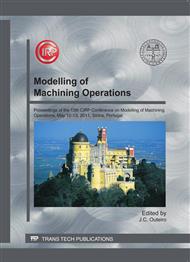[1]
Ahmed, N.; Mitrofanov, A. V.; Babitsky, V. I.; Silberschmidt, V. V.: Analysis of forces in ultrasonically assisted turning. In: Journal of Sound and Vibration, Vol. 308 (2007), p.845–854.
DOI: 10.1016/j.jsv.2007.04.003
Google Scholar
[2]
Heisel, U.; Wallaschek, J.; Eisseler, R.; Potthast, C.: Ultrasonic deep hole drilling in electrolytic Cooper ECu 57. In: CIRP Annals - Manufacturing Technology, Vol. 57 (2008), p.53–56.
DOI: 10.1016/j.cirp.2008.03.078
Google Scholar
[3]
Moriwaki, T.; Shamoto, E.: Ultrasonic Elliptical Vibration Cutting. In: Annals of the CIRP, Vol. 44/1 (1995), p.31–34.
DOI: 10.1016/s0007-8506(07)62269-0
Google Scholar
[4]
Babitsky, V. I.; Astashev, V. K.; Meadows, A.: Vibration excitation and energy transfer during ultrasonically assisted drilling. In: Journal of Sound and Vibration, Vol. 308 (2007), p.805–814.
DOI: 10.1016/j.jsv.2007.03.064
Google Scholar
[5]
Brehl, D. E.; Dow, T. A.: Review of vibration-assisted machining. In: Precision Engineering, Vol. 32 (2008), p.153–172.
DOI: 10.1016/j.precisioneng.2007.08.003
Google Scholar
[6]
Klocke, F.; Demmer, A.; Heselhaus, M.: Material removal mechanisms in ultrasonic-assisted diamond turning of brittle materials. In: International Journal of Product Technology, Vol. 20/4 (2004), p.231–238.
DOI: 10.1504/ijmpt.2004.004249
Google Scholar
[7]
Neugebauer, R.; Stoll, A.: Ultrasonic application in drilling. In: Journal of Materials Processing Technology, Vol. 149 (2004), p.633–639.
DOI: 10.1016/j.jmatprotec.2003.10.062
Google Scholar
[8]
Thoe, T. B.; Aspinwall, D. K.; Wise, M. L. H.: Review on Ultrasonic Machining. In: International Journal of Machine Tools & Manufacture, Vol. 38/4 (1998), p.239–255.
DOI: 10.1016/s0890-6955(97)00036-9
Google Scholar
[9]
Astashev, V. K.; Babitsky, V. I.: Ultrasonic Processes and Machines. Babitsky, V. I.; Wittenburg, J. (Ed. ) (Foundations of Engineering Mechanics). Berlin, Heidelberg, New York: Springer (2007).
DOI: 10.1007/978-3-540-72061-4_3
Google Scholar
[10]
Chang, Simon S. F.; Bone, Gary M.: Burr size reduction in drilling by ultrasonic assistance. In: Robotics and Coputer-Integrated Manufacturing, Vol. 21 (2005), p.442–450.
DOI: 10.1016/j.rcim.2004.11.005
Google Scholar
[11]
Takeyama, H.; Kato, S.: Burrless drilling by means of ultrasonic vibration. In: Annals of the CIRP, Vol. 40/1 (1991), p.83–86.
DOI: 10.1016/s0007-8506(07)61939-8
Google Scholar
[12]
Blaha, F.; Langenecker, B.: Dehnung von Zink-Kristallen unter Ultraschalleinwirkung. In: Die Naturwissenschaften, Vol. 42 (1955), p.556.
DOI: 10.1007/bf00623773
Google Scholar
[13]
Littmann, W.; Storck H.; Wallaschek J.: Reibung bei Ultraschallschwingungen. In: VDI-Berichte, Vol. 1736 (2002), p.231–237.
Google Scholar
[14]
Brinksmeier, E.; Aurich, J. C.; Govekar, E.; Heinzel, C. et al.: Advances in Modeling and Simulation of Grinding Processes. In: Annals of the CIRP, Vol. 55/2 (2006), p.667–696.
DOI: 10.1016/j.cirp.2006.10.003
Google Scholar
[15]
Fritsch, A.: Schleifen von Cermets. Dissertation Universität Hannover, (1997).
Google Scholar
[16]
Kassen, G.: Beschreibung der elementaren Kinematik des Schleifvorgangs. Dissertation RWTH Aachen, (1969).
Google Scholar
[17]
Tönshoff, H. -K; Peters, J.; Inasaki, I.; Paul, T.: Modelling and Simulation of Grinding Processes. In: Annals of the CIRP, Vol. 41/2 (1992), p.677–688.
DOI: 10.1016/s0007-8506(07)63254-5
Google Scholar
[18]
Friemuth, T.: Schleifen hartstoffverstärkter keramischer Werkzeuge. Dissertation Universität Hannover, (1999).
Google Scholar
[19]
Aurich, J. C.; Braun, O.; Warnecke, G.: Development of a superabrasive grinding wheel with defined grain structure using kinematic simulation. In: CIRP Annals - Manufacturing Technology, Vol. 52 (2003), H. 1, p.275–280.
DOI: 10.1016/s0007-8506(07)60583-6
Google Scholar
[20]
Pinto, F. W.; Vargas, G. E.; Wegener, K.: Simulation for optimizing grain pattern on Engineered Grinding Tools. In: CIRP Annals - Manufacturing Technology, Vol. 57 (2008), p.353–356.
DOI: 10.1016/j.cirp.2008.03.069
Google Scholar
[21]
Astashev, V. K.; Babitsky, V. I.: Ultrasonic cutting as a nonlinear (vibro-impact) process. In: Ultrasonics, Vol. 36 (1998), p.89–96.
DOI: 10.1016/s0041-624x(97)00101-7
Google Scholar
[22]
Littmann, W.: Piezoelektrische, resonant betriebene Ultraschall-Leitungswandler mit nichtlinearen mechanischen Randbedingungen. Dissertation Universität Paderborn, (2003).
Google Scholar
[23]
Wiercigroch, M.; Wojoweda, J.; Krivtsov, A. M.: Dynamics of ultrasonic percussive drillling of hard rocks. In: Journal of Sound and Vibration, Vol. 280 (2005), p.739–757.
DOI: 10.1016/j.jsv.2003.12.045
Google Scholar
[24]
Daus, N. -A: Ultraschallunterstütztes Quer-Seiten-Schleifen. Dissertation TU Berlin, (2004).
Google Scholar
[25]
Storck, H.; Littmann, W.; Wallaschek, J.; Mracek, M.: The effect of friction reduction in presence of ultrasonic vibrations and its relevance to travelling wave ultrasonic motors. Ultrasonics Vol. 40 (2002), pp.379-383.
DOI: 10.1016/s0041-624x(02)00126-9
Google Scholar
[26]
Heisel, U.; Eber, R.: Ultraschallbohren von Gestein- Untersuchungen zum Potential ultraschallgestützter Verfahren in der Gesteinsbearbeitung. In: wt-online, Vol. 100 (2010), H. 1/2, S. 74–80.
DOI: 10.37544/1436-4980-2010-1-2-74
Google Scholar
[27]
Tönshoff, H. K.; Hillmann-Apmann, H.; Asche, J.: Diamond tools in stone and civil engineering industry: cutting principles, wear and applications. In: Diamond and Related Materials, Vol 11 (2002), p.736–741.
DOI: 10.1016/s0925-9635(01)00561-1
Google Scholar
[28]
Warnecke, G., Zitt, U.: Kinematic Simulation for Analyzing and Predicting High-Performance Grinding Processes, Annals of the CIRP Vol. 47/1 (1998), pp.265-270.
DOI: 10.1016/s0007-8506(07)62831-5
Google Scholar
[29]
Zitt, U. -R.: Modellierung und Simulation von Hochleistungsschleifprozessen, Dissertation TU Kaiserslautern, (1999).
Google Scholar
[30]
Braun, O.: Konzept zur Gestaltung und Anwendung definiert gesetzter CBN-Schleifscheiben. Dissertation TU Kaiserslautern, (2008).
Google Scholar


